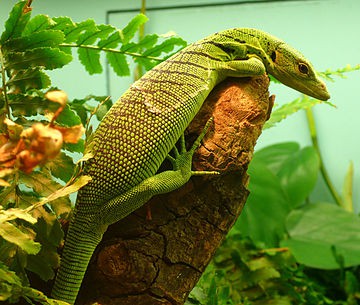Type the name of the breed you're looking for below
[wpdreams_ajaxsearchlite] Don't see the breed your're looking for? Click here and let us know!
Green Tree Monitor
| Place of Origin and Range | These monitors are found in New Guinea. |
| Description | It is known for its unusual colouration, which consists of shades from green to turquoise, topped with dark, transverse dorsal banding. This colouration helps camouflage it in its arboreal habitat. Its colour also makes the emerald tree monitor highly exploited to the pet trade and kept in zoos alike. |
| Morph Patterns Available | Yes |
| Adult Size | Can grow up to 3 feet ( 0.9 m ) |
| Accommodation | A large vertically oriented cage. Lots of shade and climbing spots. A day basking spot at approximately 100F( 36 C). Always include a large dish of water for bathing. |
| Lifespan | Can live up to 15 years |
| Feeding / Diet | Their main foods in captivity are whole prey, such as mice, rats, snakes, lizards, freshwater mollusks, small birds, large roaches, crustaceans, fish, and eggs. A varied diet with dusted insects, crayfish and other low fat foods is by far the best, but they will readily eat mice. |
| Breeding | Clutches consist of up to five eggs, each weighing 10.5–11.5 g (0.37–0.41 oz) and measuring about 2 by 4.5 cm (0.79 by 1.77 in). As many as three clutches are laid throughout the year; clutches have been laid by captives in January, March, April, November, and December. The female emerald tree monitor lays her eggs in arboreal termite nests. The eggs hatch between 160 and 190 days later, typically from June to November, after which the young eat the termites and the termite's eggs within minutes of hatching. |



